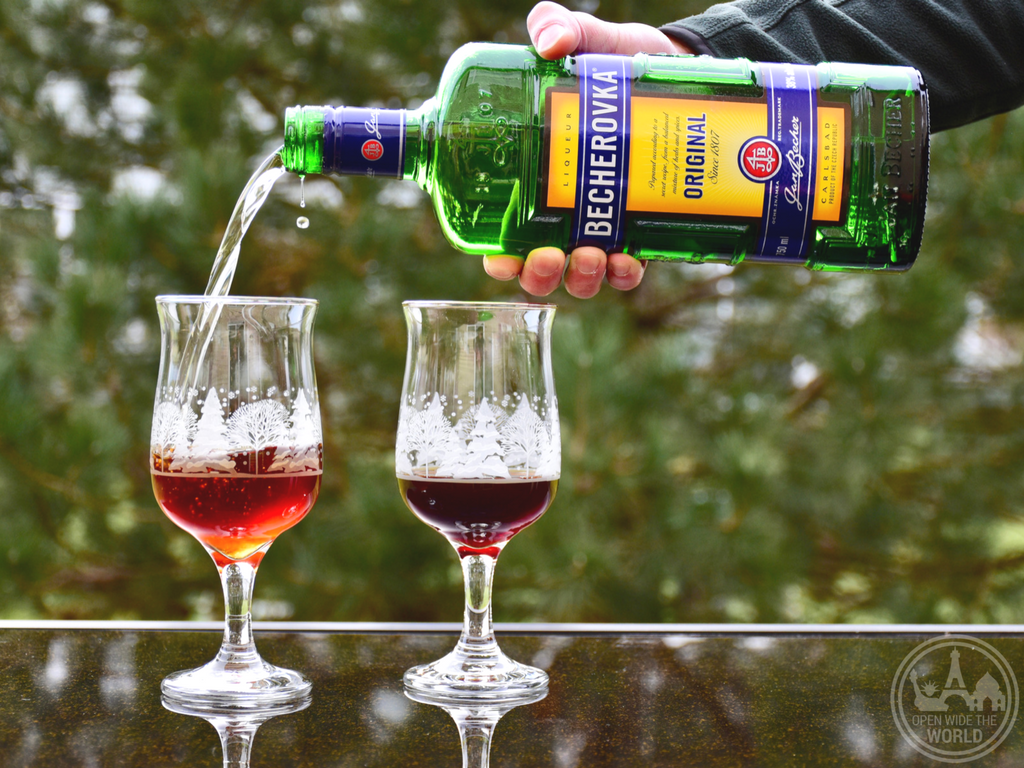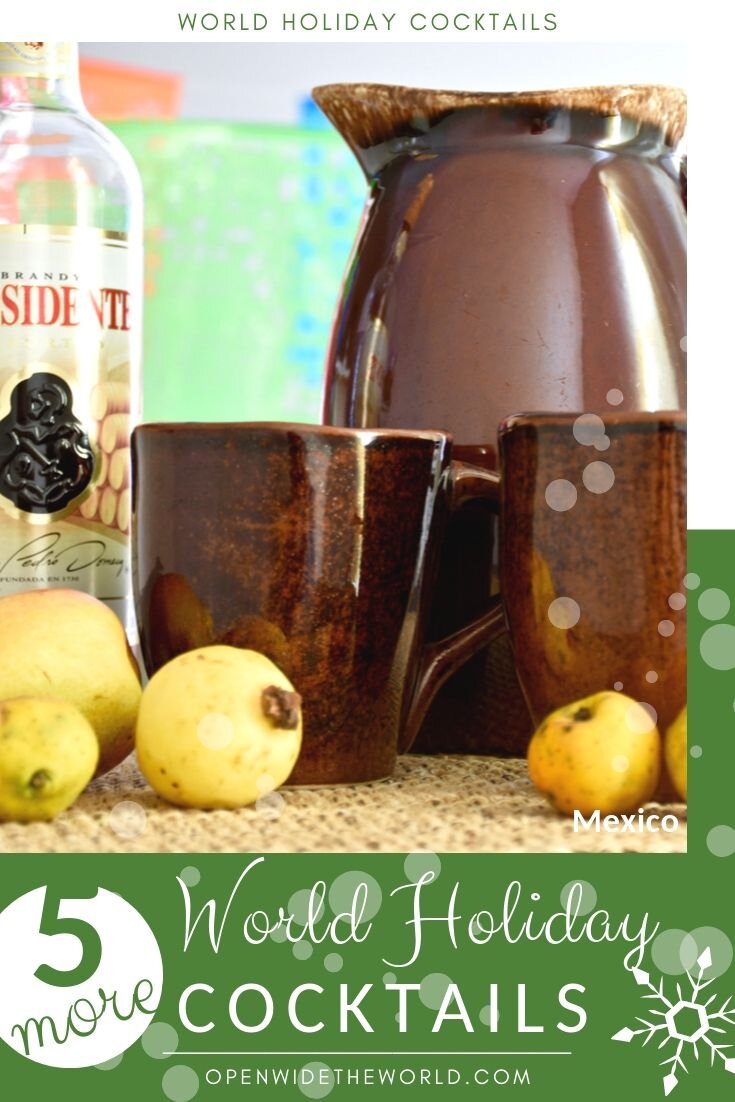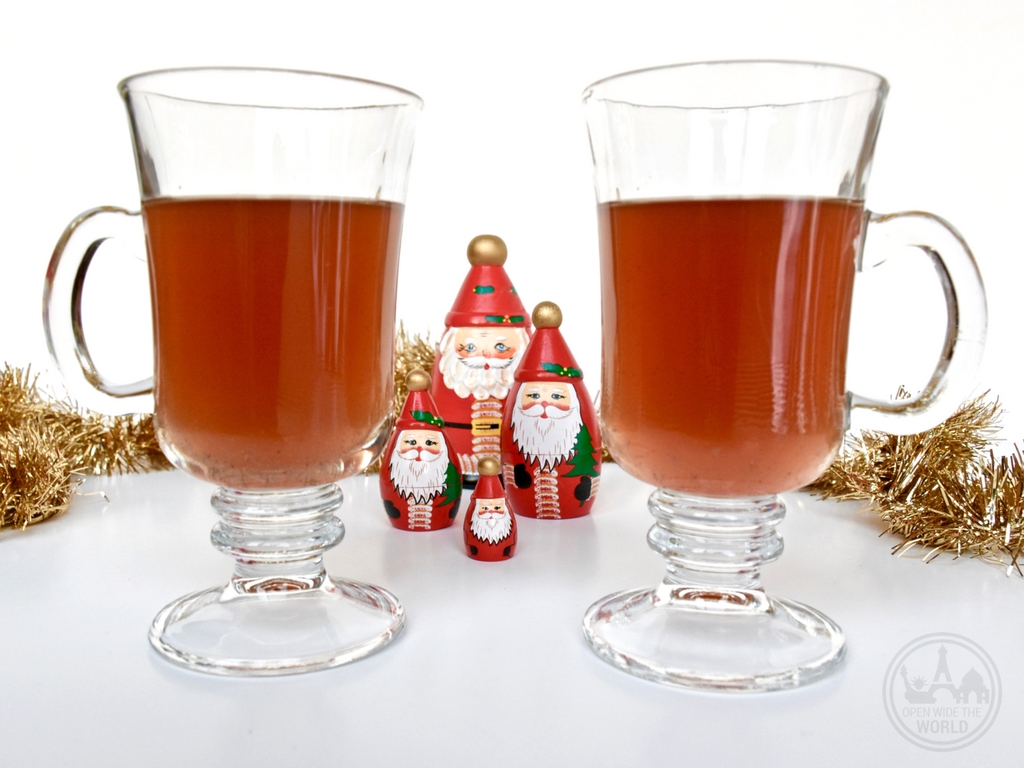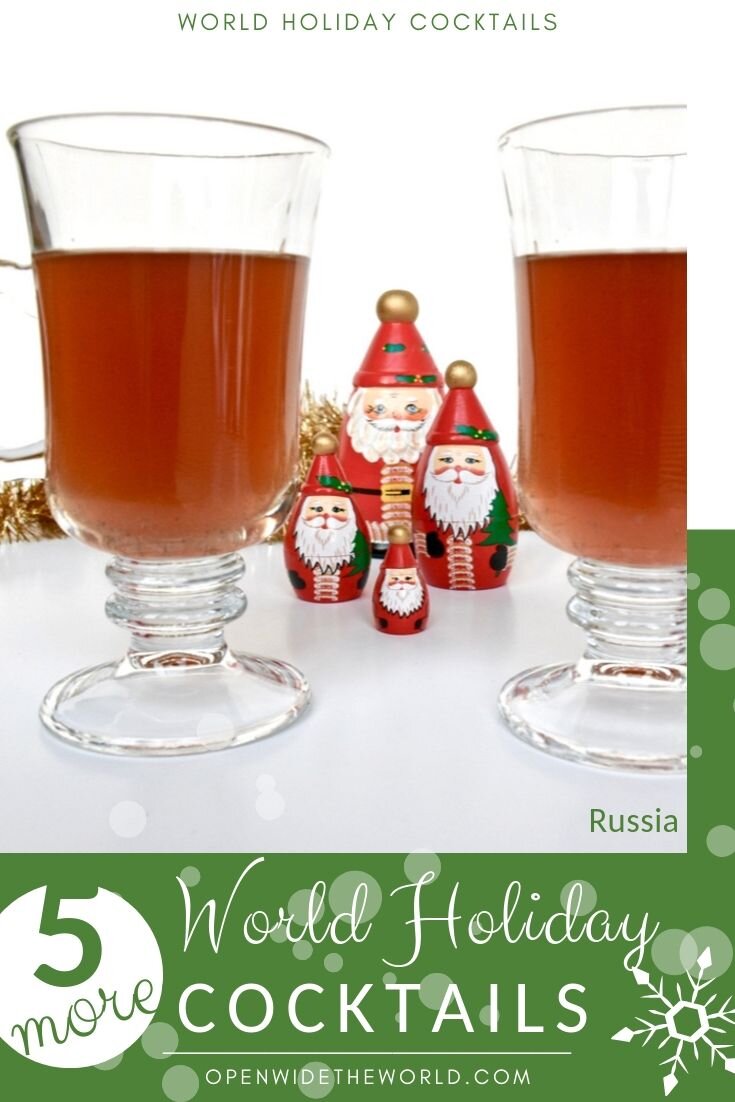World History through 5 More Festive Christmas Cocktails
We're in one of those chapters in life when holiday travels don't happen. Extended family commitments, a career that peaks in the winter months; we're home all season. Some phases in life are just like that.
But we love the challenge of embracing our travel spirit from home when needed, and actually look forward to experiencing the world through its festive drinks each holiday season. (See last year's featured drinks here.)
If you're home for the holidays, grab your shaker and join us!
Argentina: Anana Fizz
Although pineapples are most commonly associated with Hawaii, they hadn’t actually arrived in the Pacific Islands until the 1770s, transported there by British explorer Captain James Cook.
The Brits had known of pineapples since their import to the Old World in the mid 1550s, following Magellan’s “discovery” of them in Brazil. (Apparently, Columbus had had earlier exposure to the fruit in the Caribbean on his second voyage in 1493, and it was he who gave it the name piña des indes, for its resemblance to a pinecone. But it was Magellan’s crew who began the export of the fruit.)
Prior to European contact, the pineapple is believed to have been native to the region of present-day Brazil, Argentina and Paraguay, with written records of its existence going back almost three thousand years.
Early Guarani (indigenous) populations called the pineapple nanã, meaning “excellent fruit” (the ã being a pronounced as nasalized /ah/). The nanã was a staple of feasts and religious rituals, and was also used to produce wine.
A descendent of those early wine-like pineapple concoctions lives on today in the pineapple’s homeland, especially during the Christmas season. Over the holidays, Argentinians imbibe in sometimes copious amounts of anana fizz, an alcoholic, cider-like pineapple drink.
In Argentina, anana fizz is often purchased pre-made, but a smoother finish can be achieved with a homemade version, like our favorite, below.
Anana Fizz Recipe
Yield: 3 servings
You will need:
1 slice of fresh pineapple, rind and core removed, cut into thirds
6 oz. pineapple juice
6 oz. sparkling wine (We prefer dry.)
Muddle a third of the pineapple slice into each of three champagne flutes.
Add 2 oz. pineapple juice to each glass.
Top each with 2 oz. sparkling wine.
¡Salud!
Pin this post!
Czech Republic: Coffee with Becherovka
Not limited to Christmas season consumption -in fact, consumed in the warmer months just as often-, Becherovka is included in this list because first time Czech visitors often exclaim, “Oh! This tastes like Christmas,” making it a perfect addition to a list of Christmas drinks around the world.
When Becherovka was first released in 1807 by Josef Becher, it was promoted as a medicinal tincture to cure stomach illness. And it was consumed under that guise for at least its first 100 years, as records of a maritime transport company purchasing it to ease nausea would indicate.
The Becher family successfully kept close guard on their “medicinal” recipe for almost a century and a half, typically with only two members of the family having access at a given time.
But when then-Czechoslovakia expelled ethnic Germans during WWII and nationalized German property, Josef’s great-great granddaughter Hedda Becher was forced to give the original hand-written recipe to communist authorities and leave the country.
Hedda recreated and sold the drink during her exile in Cologne, Germany. From there, she distributed her Becherovka-copy only to non-Communist countries, thus was not a competitor of the newly-Communist Becherovka-original, and so was allowed to continue.
After the fall of the Soviet Union in 1989, Hedda returned to a post-Soviet Czechoslovakia, and re-privatized Becherovka, reestablishing the company’s heritage.
Today, Becherovka is consumed neat as an aperitif (before dinner) or as a digestif (after dinner), as well as being the main ingredient in the popular Beton cocktail (Becherovka, tonic, squeeze of lemon, over ice), and occasionally added to coffee, which is how we choose to feature it in this winter season post.
Coffee w/Becherovka Recipe
Yield: 1 serving
You will need:
8oz. cup brewed dark roast coffee, hot
1 oz. Becherovka
Stir together. Serve warm in coffee cup.
Becherovka-Coffee Cordial
Yield: 6 servings
You will need:
3 oz. brewed dark roast coffee, hot
6 oz. Becherovka
Stir together. Serve warm in cordial glasses.
Pin this post!
Na zdraví!
We participate in Amazon's affiliate program, which allows sites to earn advertising fees. There is no additional cost to readers making Amazon purchases through our site.
Mexico: Ponche Navideño
Fermented beverages did exist in pre-Columbian Mexico, in the form of crude beer- and wine-like beverages. These alcohols were enjoyed in moderation most any time; at intoxicating levels only during sanctioned religious ceremonies (including human sacrifices, which could claim the lives of scores of thousands in a single year).
Distillation processes arrived with the Spanish, allowing for the evolution of the tequilas, mescals, and Mexican brandies we know today. And any one of these distilled liquors can be added to Mexico's (probably 16th century) ponche navideño.
Ponche navideño, or Christmas punch, is a warm, fruity drink enjoyed throughout the Christmas season. It is especially popular during Las Posadas, the nine days leading up to Christmas, when it is offered -along with buñuelos (a fried sweet dough)- to caroling neighbors.
Ponche Navideño Recipe
Yield: 16 servings. You will need:
16 cups (1 gallon) water
8 oz. chopped piloncillo (or 1 cup packed dark brown sugar)
2 cinnamon sticks
8 tejocotes (or crab apples), cored & diced
6 large guavas, diced
1 medium pear, peeled, cored and diced
1 cup pitted prunes
5 tamarind pods, husks removed, and seeded
1/2 cup raisins
1 medium orange, sliced
8 whole cloves
10 4-inch sugar cane sticks, peeled and quartered length-wise
16 oz. brandy (For authenticity, try Domecq's Presidente, Mexico's best-selling brandy!)
Pin this post!
Bring water to a low boil in a large pot.
Add the piloncillo (or brown sugar), cinnamon sticks, and fresh tejocotes. (If using canned tejocotes, don’t add until the next step.) Simmer about 15 minutes, stirring occasionally.
Add the guavas, pear, prunes, tamarind pods, raisins, orange slices and cloves (and tejocotes, if using canned).
Simmer for an hour. (Or longer for a wonderful smelling kitchen!)
Ladle ponche and diced fruit into mugs. Add 1 oz brandy to each mug. Garnish with sugar cane sticks.
¡Salud!
Poland: Krupnik
Fermented honey drinks are believed to be the world’s oldest alcohols, with ancient peoples of Europe, Asia and Africa consuming honey meads as far back as 3000 BC.
While alcohol production evolved in infinite ways over the following five millennia, modern Poles continue to enjoy the flavor of honey in their alcohol. Krupnik, a Polish-Lithuanian honey nalewka (an infused, aged cordial), is especially popular in the Christmas season.
Krupnik is believed to have originated in a 17th century Benedictine monastery in the (then) Polish-Lithuanian Commonwealth. The monks infused a honey mead-like alcohol with spices like nutmeg and pepper, which were available thanks to the Commonwealth’s trade relations with Asia and Southeast Asia.
Krupnik may have initially been accessible only to clergy and nobility. But it appears to have been fairly quickly discovered by commoners, with women taking up its production in their farmhouse kitchens. As such, variations abound, with each region, and each family even, having its own (sometimes well-guarded) recipe. Ingredients commonly include allspice, vanilla, nutmeg, clove, and cinnamon; and in some cases, orange zest and even coffee, and occasionally up to 50 natural additives.
Families make enough krupnik to age and store, ready to offer guests year-round. In winter months, krupnik is served warm, and sipped from cordial glasses, often accompanied by chocolate or another small sweet treat.
Krupnik is traditionally the only alcohol served at the solemn wigilia, or Christmas Eve dinner.
Krupnik Recipe
Yield: 24 cordial-sized servings. You will need:
1 cup honey (We like wildflower honey over clover honey for its stronger taste.)
1 cup water
1 star anise
4 cloves
1/4 tsp ground nutmeg
5 cinnamon sticks
1 split vanilla bean (or 2 tsp vanilla extract)
1/2 orange, zested
6 peppercorns
2 cups vodka
Over medium heat, combine the water and honey. Bring to a boil, stirring occasionally, then reduce to a simmer.
Add the star anise, cloves, nutmeg, cinnamon, vanilla, orange zest and peppercorns. Simmer for 30 minutes.
Remove from heat. Add alcohol. Stir to combine.
Allow to cool before bottling. Let sit in a cool, dark place for one week, or longer.
Strain out spices before serving. Heat to serve warm in cordial glasses or similar. Offer with a small piece of chocolate or other sweet treat.
Pin this post!
Na zdrowie !
Russia: Sbiten (сбитень)
It is hard to believe that Russia, which shares more than 2500 miles (4000 km) of border with China, did not encounter tea until the 17th century. Yet, it wasn’t until the early 1600s that tea was brought from China as a gift to Tsar Michael Romanov.
So what were Russians drinking during the long, cold winter months before the arrival of tea? Sbiten!
Sbiten is a water- and herb-based drink, possibly dating from as early as the 12th century. Sbiten can be produced with or without wine, and more recently, with vodka. Non-alcoholic sbiten was traditionally consumed daily by many Russian families. It was considered a home remedy for numerous illnesses, from the common cold to depression.
When made with wine, sbiten was traditionally brewed in samovars (heated metal urns with a spigot) in taverns. Wine-free sbiten was brewed and sold on the streets by sbitenschiks. It was especially popular during festivals.
After the arrival of tea, sbiten slowly fell out of daily life in Russia. However, it is enjoying a renewed interest today, as it begins to appear again on restaurant menus and to be served again from stalls in winter markets.
Recipes for sbiten are as numerous as the herbs that can be used in its creation, and even vary by region within Russia. Below is a basic starter recipe that we enjoy.
Sbiten Recipe
Yield: 8 servings
You will need:
8 cups water
2/3 cup honey (As always, we prefer wildflower honey over clover honey for its stronger taste.)
2 cinnamon sticks
12 bay leaves
9 cloves
2 cardamon pods, split
4 mint leaves
1/4 tsp rosemary
1/4 tsp thyme
1/4 tsp fennel
a few gratings of ginger (or 1/8 tsp ground ginger)
a few gratings of nutmeg (or 1/8 tsp ground nutmeg)
4 cups port (or dry red wine)
Directions:
Combine water and honey in a pot. Bring to a boil and stir until honey dissolves.
Reduce heat to a simmer and add remaining ingredients, except alcohol. Simmer for 30 minutes.
Reduce heat to low, add the alcohol, and stir until heated through.
Serve warm in mugs.
твоё здоровье! [tva-jó zda-ró-vye]
Options
For a sweeter, more glühwein-esque taste:
Reduce the mint, rosemary, thyme and fennel. Increase the honey, cinnamon and nutmeg.
For an earthier, herbier taste:
Decrease the honey and mint. Increase the bay leaves, rosemary, thyme and fennel.
For a stronger kick:
Substitute vodka for port/wine. Or add vodka and port/wine!
For the kids:
Remove some sbiten from the pot before adding alcohol.











